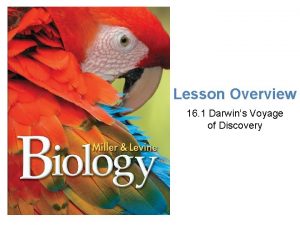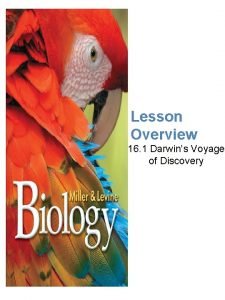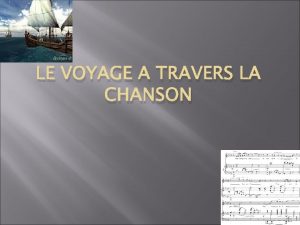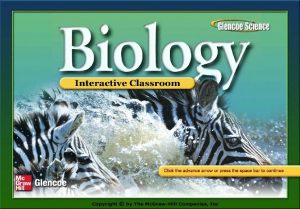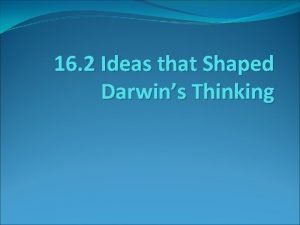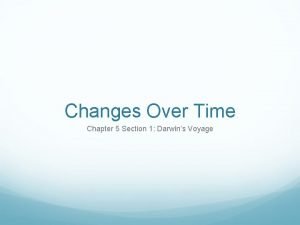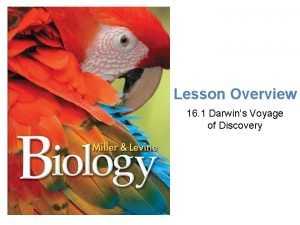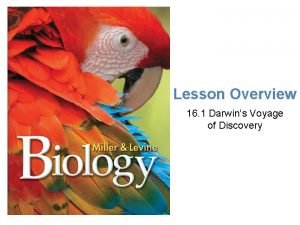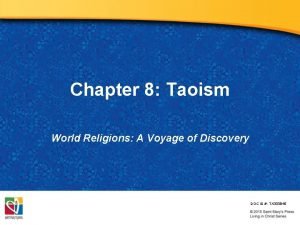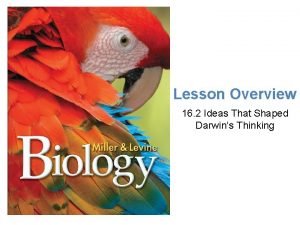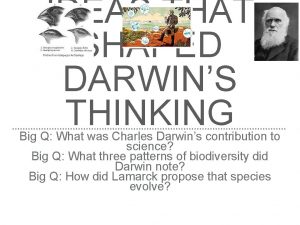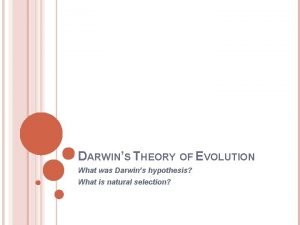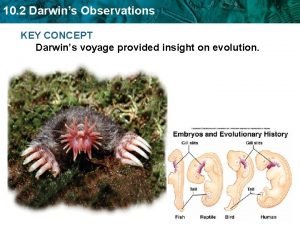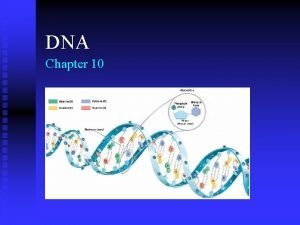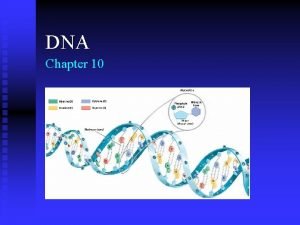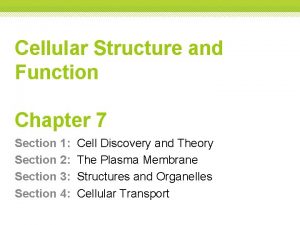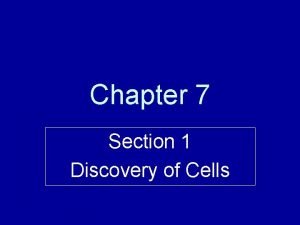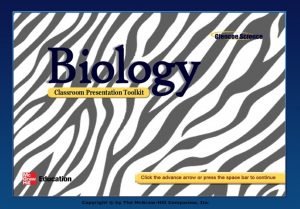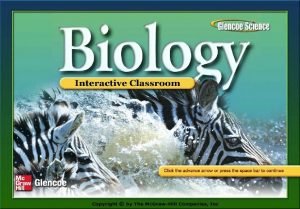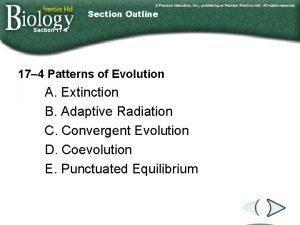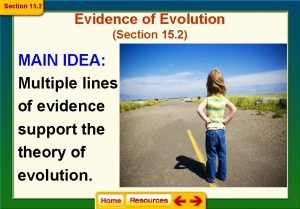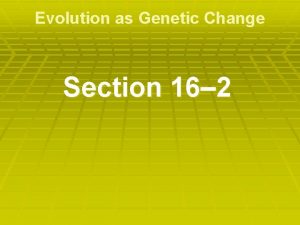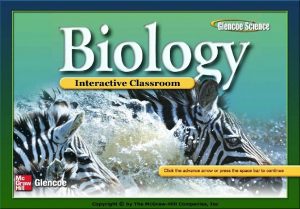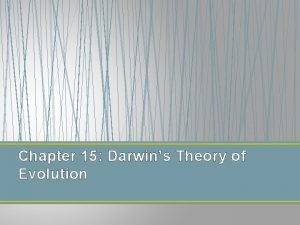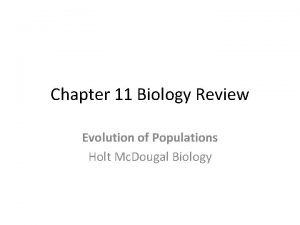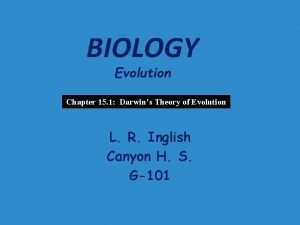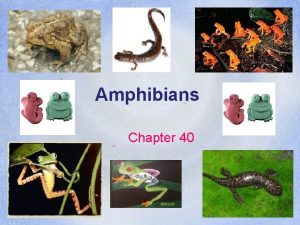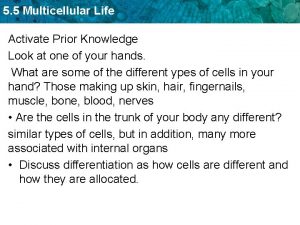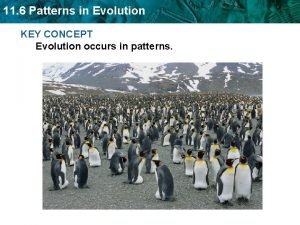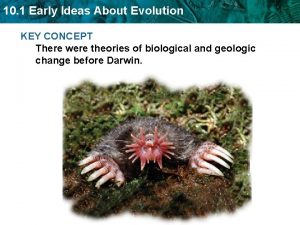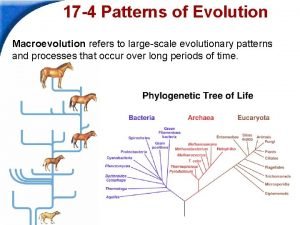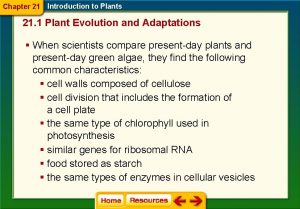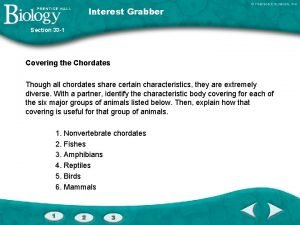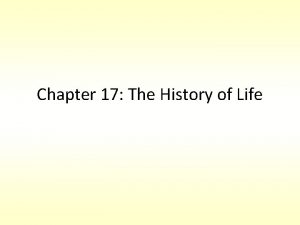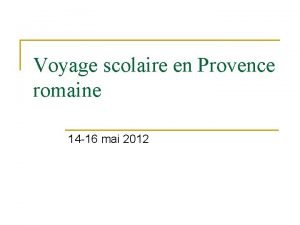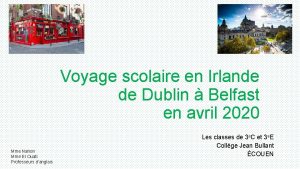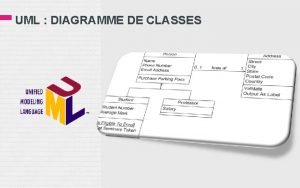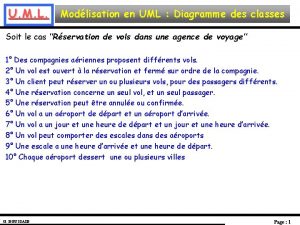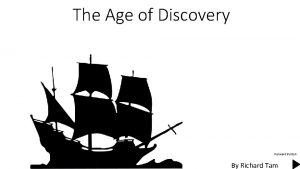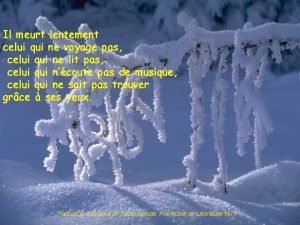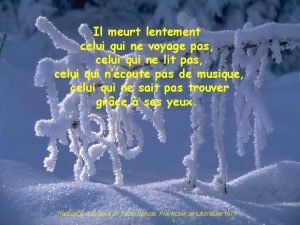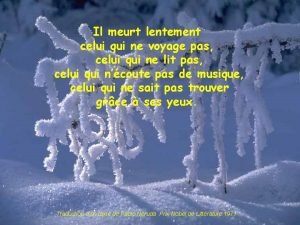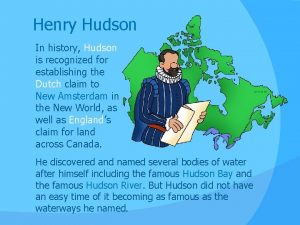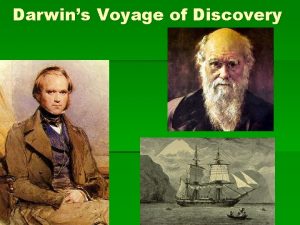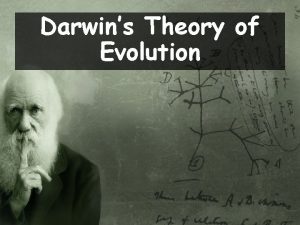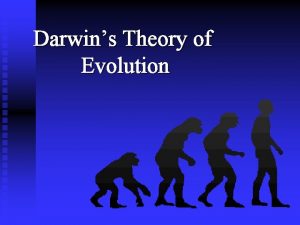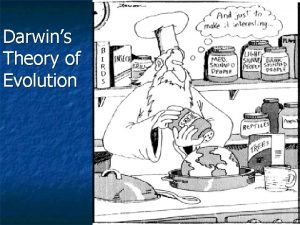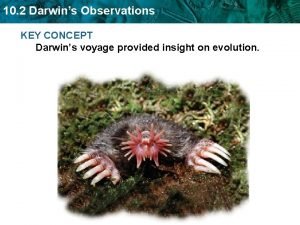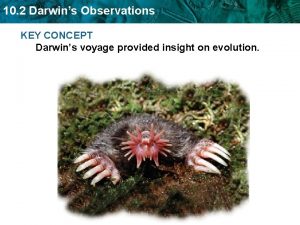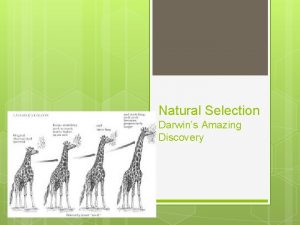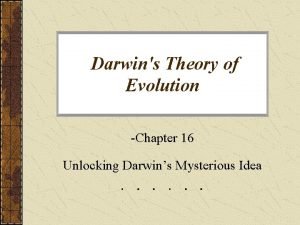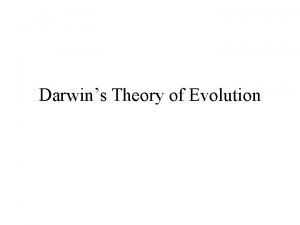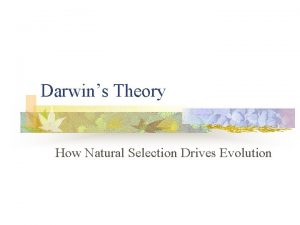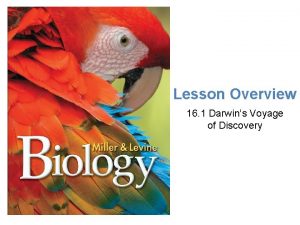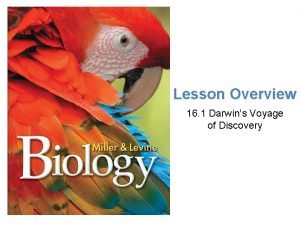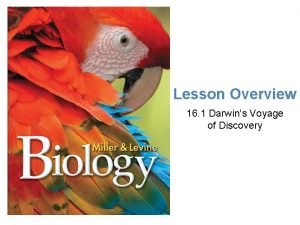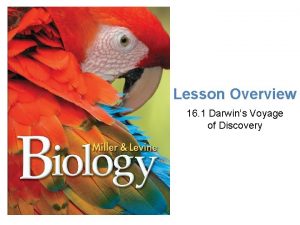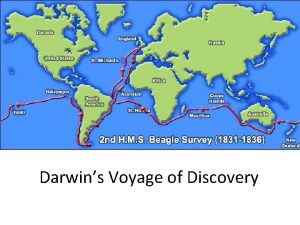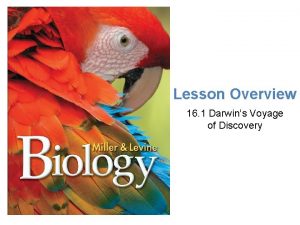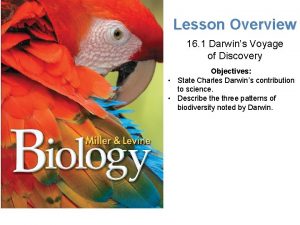Section 16 1 Darwins Voyage of Discovery Evolution

























































- Slides: 57

Section 16. 1 Darwin’s Voyage of Discovery

Evolution The theory of evolution was created by an English scientist by the name of CHARLES DARWIN. Evolution: Change in species over time

Evolution Biological Evolution theorizes how modern organisms evolved over a long period of time through descent from common ancestors. Darwin’s Voyage 1. 1831 Darwin began his journey traveling by a sail boat named the HMS Beagle 2. Voyage was taken along the coastline of South America. 3. Total voyage was five years. 4. Darwin collected specimens of different plants and animals and conducted observations along the way. Developments of distinctive patterns of biological diversity: 1. 2. 3. Species vary globally Species vary locally Species vary over time

Evolution Species vary globally Flightless bird 1. Rheas lived only in the grasslands of South America (look and act like ostriches) 2. Ostriches live only in the grasslands of Arica 3. Emu lived only in the grasslands of Australia Conclusion: Different , yet ecologically similar animal species inhabited separately SIMILAR species, SIMILAR environments, DIFFERENT locations

Indochinese tiger: only found in Asia, the slimmest body of all the tiger species Sumatran Tiger: The darkest and most striped of all the tiger species South China Tiger: only found in South China, the rarest, their fur is light orange

Evolution Species vary locally Flightless bird 1. Darwin found two species of Rheas living in South America Argentina’s grassland Colder, harsher grass and scrubland to the south Conclusion: Different , yet related animal species occupied different habitats within a local area. RELATED species, DIFFERENT environments, SAME area

Evolution Mockingbird of South America Wren bird of Argentina Blackbird of South America Warbler bird of Galapagos Island

Evolution Species vary Over Time Darwin also collected Fossils: Preserved remains or traces of ancient organisms Marine Mollusks Conclusion: Some fossils of extinct animals were similar to living species. EXTINCT species are similar to LIVING species

Species vary Over Time Evolution (A) Pan troglodytes, chimpanzee, modern (B) Australopithecus africanus, STS 5, 2. 6 My (C) Australopithecus africanus, STS 71, 2. 5 My (D) Homo habilis, KNM-ER 1813, 1. 9 My (E) Homo habilis, OH 24, 1. 8 My (F) Homo rudolfensis, KNM-ER 1470, 1. 8 My (G) Homo erectus, Dmanisi cranium D 2700, 1. 75 My (H) Homo ergaster (early H. erectus), KNM-ER 3733, 1. 75 My (I) Homo heidelbergensis, “Rhodesia man, ” 300, 000 – 125, 000 y (J) Homo sapiens neanderthalensis, La Ferrassie 1, 70, 000 y (K) Homo sapiens neanderthalensis, La Chappelle-aux-Saints, 60, 000 y (L) Homo sapiens neanderthalensis, Le Moustier, 45, 000 y (M) Homo sapiens, Cro-Magnon I, 30, 000 y (N) Homo sapiens, modern

1. 2. Charles Darwin conducted most of his experiments on an Island called Galapagos He studied many animals and plants that were unique to the island, but similar to other species elsewhere. Therefore he begin to question if different species evolved from South American Ancestors

Section 16. 2 Darwin’s Theory of Evolution

Hutton and Geological Change 1. Recognized the connection between geological processes and features (mountains, valleys, and layers of rock develop from molt, rain, wind, heat and cold over time). Lyell’s Principle of Geology 1. 2. Concluded – Earth must be older than a few thousand years. Introduced the concept of deep time (Earth’s history is too long for man to date back uniformationarianism, which states that processes seen today, must have been the same in the past that shaped Earth millions of years ago. 2. 1. Coined the term Ex: Volcanoes erupted back then and released lava and gases, as they do today

Lamarck’s Ideas Jean Baptiste Lamarck Organisms change and acquire features that help them survive in their environments. (Ex. Water birds acquired long legs because they began to wade in deeper water looking for food. Organisms could change their individual structures by not using them. (Ex. Birds do not use their wings, so the wings become smaller) Traits altered by an individual organism during its life are called ACQUIRED CHARACTERISTICS Inheritance of acquired characteristics – Acquired traits that are passed down to offspring over generations

Lamarck’s Evolutionary Hypothesis Organisms could change during their lifetime by selectively using or not using diverse parts of their body. He proposed that these traits are passed down to offspring, allowing change over time. His hypothesis was incorrect, as traits acquired by individuals cannot be passed to offspring Jean Baptiste Lamarck

POPULATION GROWTH English economist by the name of Thomas Malthus noted that humans were being born faster than people were dying, causing overcrowding. He reasoned that if the human population grew unchecked, there wouldn’t be enough living space and food. Forces that work against population growth: a. War b. Famine c. Disease From these findings Darwin questioned the mode of survival of the fittest.

There are two types of survival selection n Artificial Selection n Natural Selection ARTIFICIAL SELECTION: Selective breeding of organisms to produce offspring with the certain traits.

Section 16. 3 Darwin Presents His Case

Natural Selection: a process where organisms with strong traits survive and weak traits die 1. Occurs- in any situation where there are more individuals that are born than can survive Classification Kingdom: Animalia Phylum: Chordata Class: Mammalia Order: Carnivora Family: Felidae Genus/Species: Panthera tigris

The concept of EVOLUTION BY NATURAL SELECTION 1. a. b. c. Darwin concluded that members of a population must compete to get: Food Living space Other life necessities that may be limited 2. Darwin hypothesized that some variation of traits are better suited for life and survival Ex. Predators that are faster, stronger, and have longer claws can catch more prey.

3. An inherited characteristic that increases an organism’s ability to survive and reproduces in it’s environment is called an ADAPTATION. A. Adaptations include: - body parts (tiger’s claws) - colors (camouflage, or mimicry). Ex. Camillion - physiological function ( how a plant carries out photosynthesis) - behaviors (how prey avoid predators, such as an armadillo curling up into a ball)

4. Darwin proposed that different adaptations affect an individuals fitness. 5. FITNESS – describes how well an organism can survive and reproduce in it’s environment. 6. Those organisms with a better chance of survival and reproduction due to their adaptations are said to have high fitness. 7. Organisms that are not well suited for their environment and die off without reproduction or leave few offspring are said to have low fitness. 8. The difference in rates of survival is called “Survival of the Fittest” - note: survival means staying alive and reproduction and the passing of adaptations to the next generation.

MODES OF NATURAL SELECTION Struggle for Existence Variation and Adaptation Survival of the fittest Natural Selection Organisms produce more offspring than can survive (Spider eggs) Because the green color serves as a camouflage from predators, the green grasshoppers have a higher fitness than the yellow ones. There is a variation in nature called adaptations that increase an individual’s chance of survival and reproducing Green grasshoppers become more common than yellow grasshoppers in this population over time.

COMMON DESCENT 1. COMMON DESCENT- All species, living and extinct are descended from ancient common ancestors “ Tree of life” 2. Natural selection depends on the ability of organisms to reproduce, which means to leave descendents.

COMMON DESCENT 3. Darwin proposed that - over generations, adaptation could cause successful species to evolve into new species. - living species are descended with modification from common ancestors – called descent with modification 4. Hutton and Lyell contribution to Darwin’s theory : - deep time gave enough time for natural selection to act. - Darwin used the fossil record as evidence of descent with modification over long periods of time

Section 16. 4 Evidence of Evolution

BIOGEOGRAPHY How does the geographic distribution of species today relate to their evolutionary history? 1. Key Concept 1 –Biogeography a. Biogeography = the study of where organisms live now and where they and their ancestors lived in the pass. b. We are able to tell how modern organisms evolved from their ancestors by comparing living and fossil species. c. Two biogeographical patterns are important to Darwin’s theory 1. closely related species differ in slightly different climates EX. Over time, natural selection produced variations within populations that resulted in different, but closely related species on the island of Galapogos. 2. distantly related species develop similarities in similar environments. EX. Similar ground dwelling birds inhabit similar grasslands in Europe, Australia, and Africa. ( Differences in body structures among those animals provide evidence that they evolved from different ancestors. However, similarities among the animals, provide evidence that distantly related species to develop similar adaptations)

BIOGEOGRAPHY How do fossils help to documents the descent of modern species from ancient ancestors? 2. Key Concept-2 a. Many recently discovered fossils form series that trace the evolution of modern species from extinct ancestors. EX. (A) Pan troglodytes, chimpanzee, modern (B) Australopithecus africanus, STS 5, 2. 6 My (C) Australopithecus africanus, STS 71, 2. 5 My (D) Homo habilis, KNM-ER 1813, 1. 9 My (E) Homo habilis, OH 24, 1. 8 My (F) Homo rudolfensis, KNM-ER 1470, 1. 8 My (G) Homo erectus, Dmanisi cranium D 2700, 1. 75 My (H) Homo ergaster (early H. erectus), KNM-ER 3733, 1. 75 My (I) Homo heidelbergensis, “Rhodesia man, ” 300, 000 – 125, 000 y (J) Homo sapiens neanderthalensis, La Ferrassie 1, 70, 000 y (K) Homo sapiens neanderthalensis, La Chappelle-aux-Saints, 60, 000 y (L) Homo sapiens neanderthalensis, Le Moustier, 45, 000 y (M) Homo sapiens, Cro-Magnon I, 30, 000 y (N) Homo sapiens, modern

Anatomy Scientist use structural similarities as evidence that organisms evolved from a common ancestor HOMOLOGOUS STRUCTURE: body parts (structures) that HAVE a common evolutionary history These structures are similar in arrangement, or in function or both

Anatomy HOMOLOGOUS STRUCTURE: body parts (structures) that HAVE a common evolutionary history These structures are similar in arrangement, in function or both

ANALAGOUS STRUCTURE: body parts (structures) that do NOT have a common evolutionary history These structures are similar in function, may be different in arrangement

ANALAGOUS STRUCTURE: body parts (structures) that do NOT have a common evolutionary history These structures are similar in function, may be different in arrangement

VESTIGIAL STRUCTURE: body structure in present-day organisms that no longer serves it original purpose This whale has a pelvic bone, but it is not used In the function of the hips in humans Penguins have wings, but they do not use them to fly Mole rats have eyes, but they do not use them to see

Structural Adaptations in species develop over (time) many generations. Some structural adaptations are subtle like mimicry and camouflage MIMICRY: adaptation that allows one species to resemble another Moth caterpillar resembles a snake hover flies resemble wasp and bees

CAMAFLAUGE: when an organism blends in with their environment

Cytochrome C – homologous protein a. functions in cellular respiration b. similar cytocrhome are found in all living cells c. helped to determine evolutionary connections via chemical structures.

Hox Genes Hox genes- determine the head-too-tail axis in embryonic development. a. directs the growth of front and hind limbs. b. minor changes in an organisms genome can have major effects on body structure c. homologous hox genes are found in almost all multicellular organisms d. This concept explains how living organisms evolved through descent with modification from a common ancestor

Chapter 17 Evolution of Populations

Section 17. 1 Evidence of Evolution

Populations, not individuals can change over time How can a population’s genes change over time? a. GENE POOL: all of a populations genes together b. ALLELIC FREQUENCY: Percentage of a specific gene in a gene pool Ex: looking only at blue eyes in a population c. GENETIC EQUILIBRIUM: when genes remain the same over generations Ex. Everyone in a population is 6 ft tall, with green hair and 7 fingers. These traits remain the same for hundreds of years d. GENETIC DRIFT: When genes change in a population, due to genes leaving or entering a population

Populations, not individuals can change over time How can a population’s genes change over time? a. SINGLE-GENE TRAIT: a trait controlled by only ONE gene Ex. Gene for shell banding has two alleles. The allele for bi bands is dominant over the allele for dark bands. All genotypes for this trait have one of two phenotypes - shells with bands and without bands - single-gene traits may have two or three distinct phenotypes b. POLYGENIC TRIATS: many traits are controlled by two or more genes. Ex. Each gene for a polygenetic trait has two or more alleles. Results in single polygenetic traits having many genotypes, causing difficulty in distinguishing charactaristics.


Section 17. 2 Evidence of Evolution

Types of Natural Selection There are 3 types of natural selection Stabilizing selection Directional selection Disruptive selection STABILIZING SELECTION: natural selection favors the average INDIVIDUAL in a population Ex. If you have a population of 20 people 16 people are red 4 people are blue natural selection is going to look at 1 of the 16 red people

DIRECTIONAL SELECTION: Natural selection favors one of the two groups Ex. There are 16 red people, 4 blue people Natural selection will choose EITHER all the red people or blue people DISRUPTIVE SELECTION: Natural selection will choose both groups Ex. There are 16 red people , 4 blue people Natural selection will choose BOTH red and blue

BOTTLENECK EFFECT: the change in allele frequency following a dramatic reduction in the size of a population. Reducing genetic diversity FOUNDER EFFECT: when allele frequencies change as a result of the migration of a small subgroup of a population

Speciation: Creation of a new species Golden-mantled tree kangaroo

Section 17. 3 Evidence of Evolution

How can new species evolve or develop GEOGRAPHICAL ISOLATION: occurs when a physical barrier divides a population Ex. Mountains, lakes, rivers, canyons, deserts, oceans REPRODUCTIVE ISOLATION: occurs when formerly mating organisms, can no longer mate and produce fertile offspring Ex. A man and a Woman are able to mate, but something occurs and now they can no longer mate and produce children

How fast can new species develop? GRADUALISM: the idea that new species develop slow and gradual PUNCTUATED EQUILIBRIUM: the idea that species develop rapidly , with periods of no change (genetic equilibrium) in between

Patterns of Evolution ADAPTIVE RADIATION: when an ancestral species evolves (develops) into a variety of new species ( divergent evolution in which ancestral species evolve into an array of species to fit a number of diverse habitats)

Divergent Evolution New species are now distinct ( unique). You can tell them apart (occurs when populations change as they adapt to different environmental conditions; resulting in new species) Ex. Bengal Tiger: has a pure white Underbelly Amur Tiger: Has the least stripes of all tigers

Convergent Evolution Distantly related organisms have the similar characteristics because their environments are the same

http: //www. pbs. org/wgbh/evolution/educators/teachstuds/svideos. html

Hardy Weinberg Principle Key Concept 1 – Hardy Weinberg Principle a. b. States that allele frequencies in a population should remain constant unless one or more factors cause those frequencies to change. Makes predictions like punnet squares, but for populations, not individuals. EX. Say there were two alleles for a gene: A (dominant) and gene a (recessive). A cross of these alleles can produce three possible genotypes: AA, Aa, and aa. The frequencies of genotypes in a population can be predicted by these equations, where p and q are the frequencies of the dominant and recessive allele

Hardy Weinberg Principle EX. In symbols p 2 + 2 pq + q 2 = 1 and p +q =1 In words (frequency of AA) + (frequency of Aa) + (frequency of aa) = 100% and (frequency of A) + (frequency of a) = 100% EX: In one generation , the frequency of A allele is 40 percent (p = 0. 40), Frequency of a allele is 60 percent (q=0. 60) If these genetic equilibrium, chances of an individual in the next generation having genotype AA would be 16%

Hardy Weinberg Principle genotype AA would be 16% (p 2 = 0. 402 = 0. 16 or 16%) The probability of genotype aa would be 36% (q 2=0. 602 =0. 36 or 36%) The probability of genotype Aa would be 48% 2 pq = 2 (0. 40)(0. 60) = 0. 48 or 48% If a population does not show these predicted phenotype frequencies, evolution is taking place

Hardy Weinberg Principle b. Hardy- Weinberg principle predicts that five conditions can disturb genetic equilibrium and cause evolution to occur
 Lesson 1 darwins voyage of discovery
Lesson 1 darwins voyage of discovery Lesson 1 a voyage of discovery
Lesson 1 a voyage of discovery Chapter 17 darwin's theory of evolution
Chapter 17 darwin's theory of evolution Voyage voyage
Voyage voyage Chanson sur le thème du voyage
Chanson sur le thème du voyage Ideas that shaped darwin's thinking
Ideas that shaped darwin's thinking Chapter 15 section 1 darwins theory of natural selection
Chapter 15 section 1 darwins theory of natural selection 15-2 ideas that shaped darwins thinking
15-2 ideas that shaped darwins thinking Adaptation
Adaptation Artificial selection
Artificial selection Darwin's voyage of discovery
Darwin's voyage of discovery World religions a voyage of discovery
World religions a voyage of discovery Lesson 2: ideas that shaped darwins thinking
Lesson 2: ideas that shaped darwins thinking Section 15-2 ideas that shaped answer key
Section 15-2 ideas that shaped answer key What was darwins theory
What was darwins theory Darwins observations
Darwins observations Section 10-1 review discovery of dna
Section 10-1 review discovery of dna What type of rna
What type of rna Chapter 7 section 4 cellular transport
Chapter 7 section 4 cellular transport Chapter 7 section 1 cell discovery and theory
Chapter 7 section 1 cell discovery and theory Section 1 cell discovery and theory
Section 1 cell discovery and theory Chapter 7 section 3 structures and organelles
Chapter 7 section 3 structures and organelles 17-4 patterns of evolution answer key
17-4 patterns of evolution answer key Evolution of populations section 16-1 genes and variation
Evolution of populations section 16-1 genes and variation Section 15-2 evidence of evolution
Section 15-2 evidence of evolution Section 17-3 evolution of multicellular life
Section 17-3 evolution of multicellular life Section 16–2 evolution as genetic change
Section 16–2 evolution as genetic change Strengths and weaknesses of evolutionary theory page 386
Strengths and weaknesses of evolutionary theory page 386 Chapter 21 section 1 plant evolution and adaptations
Chapter 21 section 1 plant evolution and adaptations Evolution of populations section 16-1 genes and variation
Evolution of populations section 16-1 genes and variation 5 fingers of evolution
5 fingers of evolution Chapter 15 darwin's theory of evolution section 15-1
Chapter 15 darwin's theory of evolution section 15-1 Evolution of populations section 11 review
Evolution of populations section 11 review Chapter 15 darwin's theory of evolution section 15-1
Chapter 15 darwin's theory of evolution section 15-1 Origin and evolution of amphibia
Origin and evolution of amphibia Section 17-3 evolution of multicellular life answer key
Section 17-3 evolution of multicellular life answer key Section 6 patterns in evolution
Section 6 patterns in evolution Identify early ideas about evolution
Identify early ideas about evolution Connecting the concepts macroevolution
Connecting the concepts macroevolution Chapter 21 section 1 plant evolution and adaptations
Chapter 21 section 1 plant evolution and adaptations Section 33-1 chordate evolution answer key
Section 33-1 chordate evolution answer key Section 17-4 patterns of evolution
Section 17-4 patterns of evolution Voyage scolaire saragosse
Voyage scolaire saragosse Voyage scolaire provence
Voyage scolaire provence Voyage scolaire italie
Voyage scolaire italie Voyage scolaire belfast
Voyage scolaire belfast Voyage estimation calculation example
Voyage estimation calculation example Systeme sexagesimal
Systeme sexagesimal Composition uml
Composition uml Diagramme de classe compagnie aérienne
Diagramme de classe compagnie aérienne Types of information system
Types of information system Hernando cortes voyage route
Hernando cortes voyage route Souhait de voyage
Souhait de voyage Pablo neruda il meurt lentement
Pablo neruda il meurt lentement Il meurt lentement de pablo neruda
Il meurt lentement de pablo neruda Texte pablo neruda il meurt lentement
Texte pablo neruda il meurt lentement Il meurt lentement celui qui
Il meurt lentement celui qui Hudson 1509 route
Hudson 1509 route
